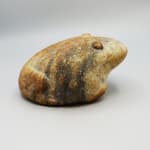Egyptian Sculpture of a Frog , 2700 BC - 1069 BC
Andesite
8.8 x 13.5 x 19.5 cm
3 1/2 x 5 1/4 x 7 5/8 in
3 1/2 x 5 1/4 x 7 5/8 in
CC.120
Further images
-
(View a larger image of thumbnail 1
)

-
(View a larger image of thumbnail 2
)

-
(View a larger image of thumbnail 3
)

-
(View a larger image of thumbnail 4
)

-
(View a larger image of thumbnail 5
)

-
(View a larger image of thumbnail 6
)

-
(View a larger image of thumbnail 7
)

-
(View a larger image of thumbnail 8
)

-
(View a larger image of thumbnail 9
)

Egypt was well-known, even in ancient times, as a land of magic. As early as the Odyssey, the Egyptian servant Polydamna is lauded as a creator of potions and spells....
Egypt was well-known, even in ancient times, as a land of magic. As early as the Odyssey, the Egyptian servant Polydamna is lauded as a creator of potions and spells. And for the Egyptians, the source of their magic was the goddess Heqet, whose avatar took the form of a frog (qerer). It was perhaps the transformation of the frog across its lifecycle that ensured an intimate connection to magic. Frogs were therefore depicted in all kinds of magical contexts, especially on the ‘wands’ of wood or ivory that were associated with magical ritual. Every year the river Nile flooded, and covered the fields in a thick layer of rich alluvial mud; as the waters receded, frogs appeared from under the mud, having been deposited as tadpoles before the flood. For the Egyptians, then, the croaking of the frog was emblematic of rebirth, another function for which Heqet had responsibility. Heqet was often seen, in the guise of a frog-headed woman, attending to Khnum, the creator-god, as he modelled the new-born Pharaoh on his potter’s wheel.
With the myriad associations of the frog in Egyptian life and culture, they were a popular subject in art right from the Predynastic Period through to the Ptolemaic Period. This charming andesite representation of a frog demonstrates the Egyptian knack for producing refined, abstracted forms which somehow maintain their realism. The frog is depicted as resting on its hind legs, which are folded tight against it. Its forelegs are represented by small ovals. The entire body is an elegant ovoid shape, with a squat face and portly stomach. The eyes are rendered as round bumps that protrude from the top of the head. The artist has taken great pains to consider the texture of the frog’s skin, choosing a kind of banded andesite with brown and blue-grey inclusions that seems to give the frog life.
Frogs were important charms and amulets in Egypt, fulfilling a variety of magical purposes, and especially expressing the desire for fertility and children. But a frog of this size and quality must have had a more substantial purpose, most likely as a votive offering to Heqet, dedicated within a temple to the goddess. But despite all its magical significance, this frog remains a charming example of the Egyptian artisan’s work.
With the myriad associations of the frog in Egyptian life and culture, they were a popular subject in art right from the Predynastic Period through to the Ptolemaic Period. This charming andesite representation of a frog demonstrates the Egyptian knack for producing refined, abstracted forms which somehow maintain their realism. The frog is depicted as resting on its hind legs, which are folded tight against it. Its forelegs are represented by small ovals. The entire body is an elegant ovoid shape, with a squat face and portly stomach. The eyes are rendered as round bumps that protrude from the top of the head. The artist has taken great pains to consider the texture of the frog’s skin, choosing a kind of banded andesite with brown and blue-grey inclusions that seems to give the frog life.
Frogs were important charms and amulets in Egypt, fulfilling a variety of magical purposes, and especially expressing the desire for fertility and children. But a frog of this size and quality must have had a more substantial purpose, most likely as a votive offering to Heqet, dedicated within a temple to the goddess. But despite all its magical significance, this frog remains a charming example of the Egyptian artisan’s work.








